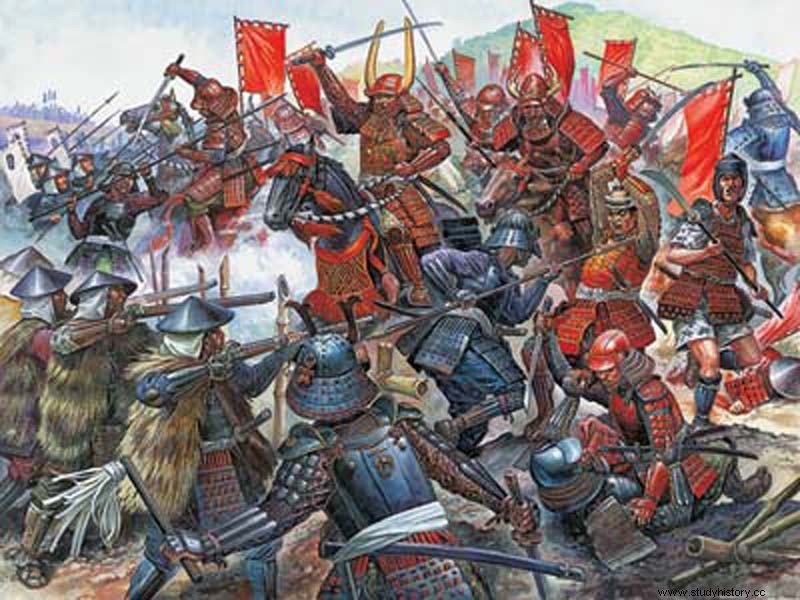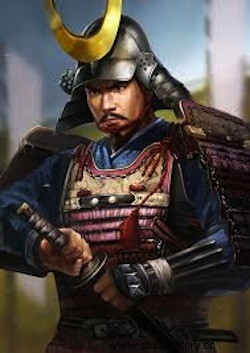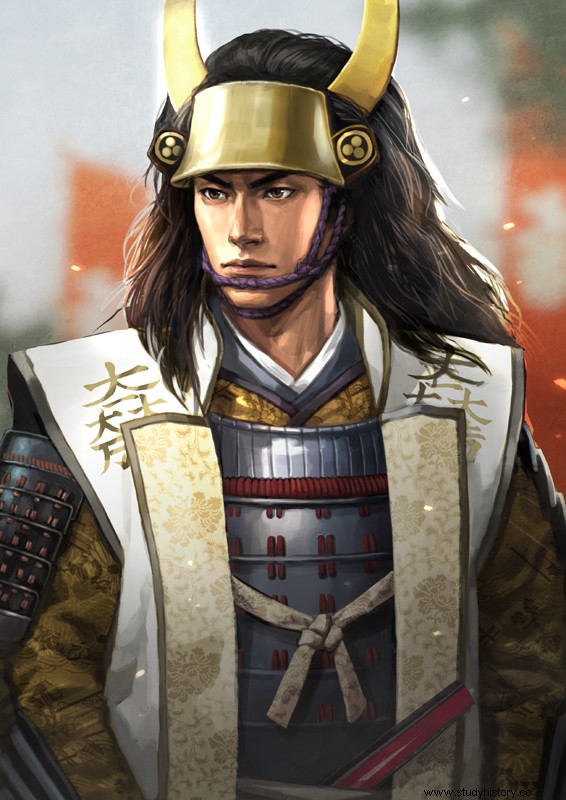At the battle of Sekigahara the destiny of Japan was played to heads or tails. The entire country was divided into two factions, the East and the West, led at the time by Tokugawa Ieyasu and Ishida Mitsunari . Years of endless and devastating civil wars had culminated in this culminating point, an all or nothing in which the fate of the island country would be sealed. The largest battle ever fought in Japanese history pitted nearly 200,000 soldiers against each other and effectively ended centuries of feudal strife and unrest. At sunset on October 21, 1600, at the end of the carnage, Ieyasu was the absolute owner of the country. His family, the Tokugawa, would rule the empire's designs as shoguns for the next 250 years.

Battle of Sekigahara
There are many stories to tell about this battle, in which entire contingents changed sides in the heat of combat and the final result was uncertain until practically the last arquebus. But, in reality, the anecdote that concerns us today took place shortly after the crash itself.
Let's put ourselves in situation. Just a year before the great battle, Japan lived in relative peace and harmony under the aegis of Toyotomi Hideyoshi , the second of the three great unifiers. Hideyoshi had successfully completed the task of unifying the untimely death of his lord, Oda Nobunaga had left unfinished. In the space of little more than 30 years, Japan had gone from being a divided country ravaged by civil wars to becoming a unitary state, subject to a central power, whose subjects enjoyed reasonable well-being and prosperity. But when Hideyoshi died in 1598, leaving an heir who was still a child, everything that had been achieved began to falter. The sound of sabers began to resound loudly throughout the empire. The wounds of the civil wars were still fresh. On the one hand, the Toyotomi house, surrounded by vassals of dubious loyalty and with a three-year-old baby as its head, was in a precarious situation. In front of them, Ieyasu, charismatic leader of the powerful Tokugawa clan and one of the heroes of the unification wars. Clever, cunning and hardened in a thousand battles, Ieyasu was without a doubt the most prestigious general in all of Japan. Many saw him as the ideal candidate, perhaps the only possible one, to straighten out the situation and ensure the stability of the country.
Ishida Mitsunari, Hideyoshi's former quartermaster, set himself up as the Toyotomi's champion and championed their cause. Mitsunari was a capable and competent administrator, but his ability as a troop commander left much to be desired. He was also no wonder as a human resources manager, precisely. His loyalty to the Toyotomi was probably sincere, but his scheming and scheming character ended up earning him quite a few enmities on his own side. In the long run, this would be the cause of his final collapse. On the other hand, the devious Ieyasu, old fox if there were any, was as adept at leading troops as he was at moving behind the scenes of high politics. He was able to attract to his side even staunch supporters of the Toyotomi who, loyal to the late Hideyoshi as they might be, could not bear to have Mitsunari as their commander. They considered him an obnoxious upstart, a lapdog for his ill-fated lord, and would rather see him crucified than lead a government on behalf of Hideyoshi's heir.
Japan was hopelessly divided in two:Ieyasu vs. Mitsunari , East against West. Feudal lords from all over the country took part on one side or the other, rarely were those who managed to remain neutral. The entire country seemed to be on a war footing.
Thus, the tensions between the two factions escalated until, in October 1600, with the period of mourning for the late Hideyoshi still to come to an end, the armies collided in the Sekigahara valley, betrayals and mass desertions occurred in the middle of the battle, just as the cunning Ieyasu had foreseen, and Mitsunari's side, which initially had the tactical advantage, ended up suffering a monumental setback. The victory was for the East. Tokugawa Ieyasu was the new owner of Japan.

Tokugawa Ieyasu
Seeing the one coming at him, Mitsunari fled with what he was wearing, followed by some of his lieutenants, but soon after Ieyasu's scouts hunted him down and he ended up in chains. The die was cast and Mitsunari had received tails. That was the end of dreams of glory and the possibility of restoring Hideyoshi's heir to his rightful throne. It only remained to wait for his head to rest on top of a pike on the banks of the Kamo River, in the capital Kyoto.

Mitsunari Ishida
Or maybe not?
To add derision to his sad fate, it was customary to take prisoners in procession to the execution ground. Days after the great battle, the inhabitants of Kyoto attended once again, probably not without a certain delight, the macabre spectacle of the last walk of those who are going to be shaved dry by katana blows. As Mitsunari was led to the old gallows of Rokujogahara , a peasant took pity on him and offered him some fruits to eat. It is said that they were persimmons, a very common fruit in those latitudes with a rather sweet taste. But, apparently, for Mitsunari the taste was the least of it. Mitsunari, who to tell the truth offered a quite wholesome appearance and seemed unusually calm for someone in such a situation, rejected the gesture with a point of sarcasm:
Persimmons feel like a stone in my stomach.
A fellow prisoner, amused by the occurrence, pointed out to him that, in his situation, heavy digestion should be the least of his worries. But Mitsunari, haughtily, simply replied that, until the end, one can never be sure what will happen. What happened is that, as planned, hours later Mitsunari was decapitated and his proud head exposed for the derision of the entire empire. A few more or fewer persimmons would have made no difference, but Mitsunari wanted to stay true to himself to the end.
Much has been speculated about the cause of such enigmatic confidence. Was there some fantastic rescue plan afoot to save his skin right under the nose of the executioner? Was he hoping that some legal trickery would allow him to appeal the death sentence? Or was it just one last gesture of arrogance? We'll never know.
They say that hope is the last thing that is lost, but in the case of Mitsunari, the topic does not seem to be confirmed. Genius and figure to the very end, he lost an empire and his head before hope.
Collaboration of R. Ibarzabal .
